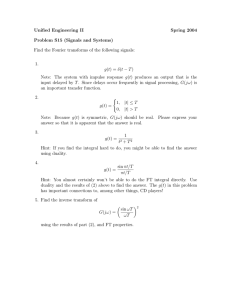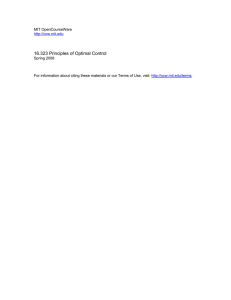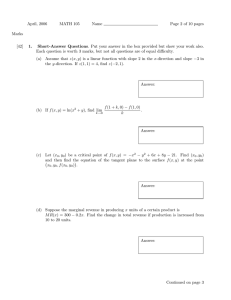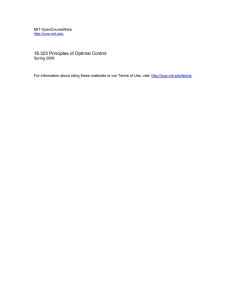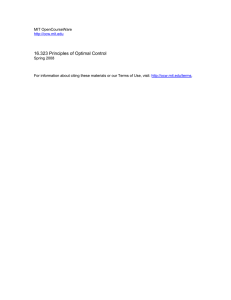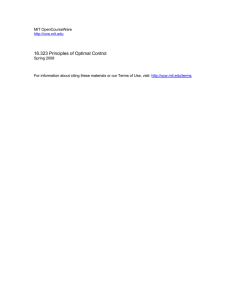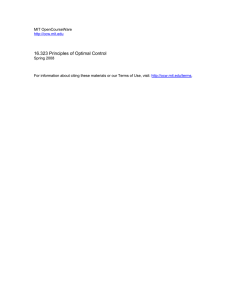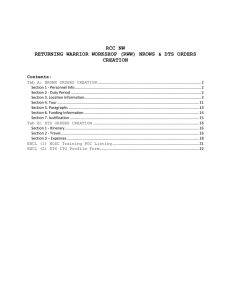16.323 Principles of Optimal Control
advertisement
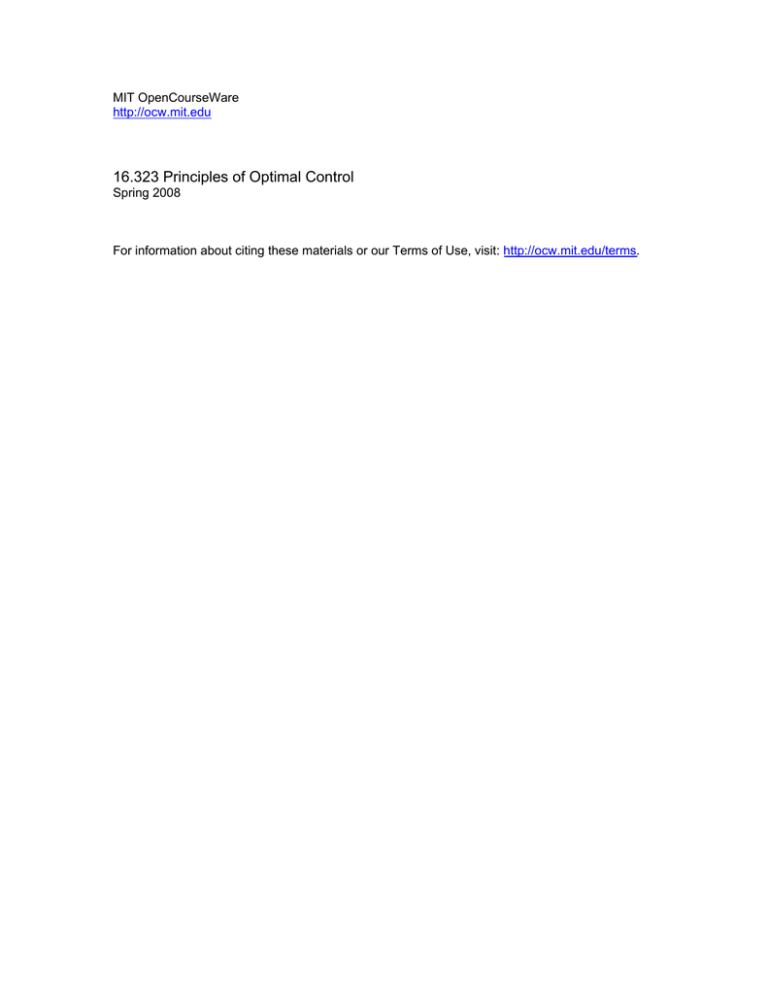
MIT OpenCourseWare
http://ocw.mit.edu
16.323 Principles of Optimal Control
Spring 2008
For information about citing these materials or our Terms of Use, visit: http://ocw.mit.edu/terms.
16.323, #32
April 11, 2007
16.323 Final Exam
This is a closed-book exam, but you are allowed 3 pages of notes (both sides). You have 3 hours.
There are six 6 questions with the relative values clearly marked.
Some handy formulas:
�
�
u (t) = arg
�
min H(x, u, p, t)
u(t)∈U
−1 T
AT Pss + Pss A + Rxx − Pss Bu Ruu
Bu Pss = 0
−1 T
Kss = Ruu
Bu Pss
��
λi
(i)
(ii)
(iii)
a b
c d
��
=
a+d±
√
a2 − 2ad + d2 + 4bc
2
PN = H
�
�−1 T
Fk = − Rk + BkT Pk+1 Bk
Bk Pk+1 Ak
Pk = Qk + FkT Rk Fk + {Ak + Bk Fk }T Pk+1 {Ak + Bk Fk }
1. (15%) Consider a model of a first order unstable plant with the state equation
ẋ(t) = ax(t) − au(t)
a > 0
and a new cost functional
� ∞
�
�
J=
e2bt x2 (t) + ρu2 (t) dt
ρ > 0, b ≥ 0
0
It can be shown that, with a change of variables in the system to ebt x(t) → x̃(t) and
ebt u(t) → ũ(t), then the only real modification required to solve for the static LQR con­
troller with this cost functional is to use A + bI in the algebraic Riccati equation instead
of A.
(a) Given this information, determine the LQR gain K as a function of ρ, a, b.
(b) Determine the location of the closed-loop poles for 0 < ρ < ∞
(c) Use these results to explain what the primary effect of b is on this control design.
2. (15%) Given the optimal control problem for a scalar nonlinear system:
ẋ = xu
x(0) = 1
� 1
2
J(u) = x(1) +
(x(t)u(t))2 dt
0
find the optimal feedback strategy by solving the associated HJB equation. Hint: show
that the HJB differential equation admits a solution of the form J � = p(t)x(t)2 .
3. (15%) For the system given by the dynamics:
ẋ1 = x2 + u
ẋ2 = u
with |u(t)| ≤ 1, find the time optimal controller that drives the system to the origin
x1 = x2 = 0. In your solution, clearly state:
• The switching law,
• Show the switching lines,
• Sketch the system response for x1 (0) = x2 (0) = 1.
4. (15%) Consider the following discrete system:
xk+1 = xk − 0.4x2k + uk
Assume that the state space is quantized to be (0, 0.5, 1), and the control is quantized to
be (−0.4, −0.2, 0, 0.2, 0.4). The cost to be minimized is
J = 4|x2 | +
1
�
|uk |
k=0
Use dynamic programming to find the optimal control sequence and complete the following
tables. If in the process you find a state that is not at the quantized value, assign it the
nearest quantized value.
�
x0 J0,2
(x0 ) u�0
0.0
0.5
1.0
�
x1 J1,2
(x1 ) u�1
0.0
0.5
1.0
Use these results to find the optimal control sequence if the initial state is x0 = 1.
5. (20%) Optimal control of linear systems:
(a) Given the linear system
ẋ = −x + u
with x(0) = 1 and x(1) = 1, find the controller that optimizes the cost functional
�
1 1 2
J=
(3x + u2 )dt
2 0
Please solve this problem by forming the Hamiltonian, solve the differential equations
for the state/costate, and then use these to provide the control law, which you should
write as an explicit function of time.
(b) Consider the following system:
ẋ1 = −x1 + u
ẋ2 = −2x2
� ∞
with J =
(x22 (t) + u2 (t))dt
0
• Comment on the stabilizability and detectability of this system.
• Find the optimal steady state regulator feedback law for the system. Why does
this answer make sense?
• Given x(0) = [ 1 1 ] what is the minimum value of the initial cost?
6. (20%) LQG control for an unstable system: Consider the unstable second order system
ẋ1 = x2
ẋ2 = x2 + u + w
with the continuous measurements
y = x1 + v
where w and v are zero-mean white noise processes with spectral densities Rww and Rvv
respectively and the performance index is
� ∞
J=
(Rxx x21 + Ruu u2 ) dt
0
You analyzed this system in Homework
#3 and showed that for Rxx /Ruu = 1 the
√ steady√
state LQR gains are K = [ 1
3 + 1 ] and the closed-loop poles are at s = −( 3 ± j )/2.
(a) Sketch by hand the locus of the estimation error poles versus the ratio Rww /Rvv for
the steady-state LQE case. Show the pole locations for the noisy sensor problem.
(b) For Rww /Rvv = 1 show analytically that the steady-state LQE gains are
� √
�
3
+
1
L= √
3+2
√
and that the closed-loop poles are at s = −( 3 ± j )/2.
(c) Find the transfer function of the corresponding steady state LQG compensator.
(d) As best as possible, provide a classical explanation of this compensator and explain
why it is a good choice for this system.
